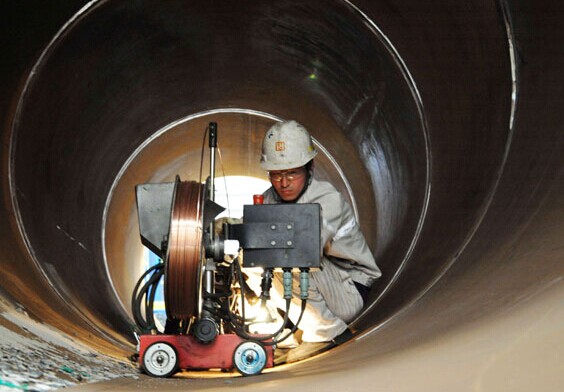

A worker welds a pipeline for an offshore oil rig at a plant in Qingdao, Shandong province. Aggregate industrial profit through April rose 10 percent more than a year earlier, compared with a 10.1 percent gain in the first quarter. Jiang Zuofeng / For China Daily
Experts say May figures likely to be better; vehicle sector stands out
China's industrial profit gains in April slowed, dragged down by a slump in the electronics, power and wine industries. Analysts said this was in line with other weak April data, but they were more optimistic about May's data.
Profits generated from industrial enterprises with annual revenue of more than 20 million yuan ($3.2 million) reported 9.6 percent year-on-year growth in April, according to the National Bureau of Statistics on Wednesday, down from the 10.7 percent growth recorded in March.
Aggregate industrial profit through April rose 10 percent more than a year earlier, compared with a 10.1 percent gain in the first quarter.
Profit growth in most of the industries was stable, while a sharp growth drop in a few industries, including electronic products, electricity production and supply, and wine and other beverages, was behind most of the slump.
Growth of industrial profit for electronic products in April grew 35.2 percent year-over-year, down from a 63.42 percent gain in March.
The electric production and supply sector was down 22.4 percentage points over the previous month, while the wine industry fell 27.9 percentage points.
Profit remains concentrated in a few industries. In absolute terms, the automotive industry contributed the largest share of newly added profit of 41.25 billion yuan in April. The power industry ranked second, with 29.21 billion yuan in newly added profit.
The two industries, along with electrical and mechanical machinery, non-metallic minerals and the electronics industry, made up 78.6 percent of the 41 industrial sectors' total profits.
While slumping coal prices sent the profits in the power industry higher, they also dealt a heavy blow to the coal-mining and smelting industry, whose profit plunged 42 percent year-on-year in the year's first four months.
Ferrous metallurgy, mainly steel manufacturing, reported a 11.3 percent profit slump, while nonferrous metallurgy's profit dropped 5.9 percent, NBS said.
Analysts said April's slowdown was in line with the industrial production data released earlier. Industrial production rose 8.7 percent in April from a year earlier, the slowest growth in five years.
Other key data, including fixed-asset investment, property investment and retail sales, also reported slowdowns in April. But leading indicators showed signs of improvement in May.
The preliminary Purchasing Managers Index for the manufacturing sector this month has beaten expectations to reach a five-month high, according to HSBC Holdings Plc. The daily electricity output growth in the first 20 days of May accelerated to 4.3 percent year-on-year.
Alan Oster, group chief economist of National Australia Bank Ltd, said he was "reasonably relaxed" about China because the focus now is on the quality rather than the quantity of the growth.
"I see China as attempting to essentially slow down shadow banking, slow down housing and trying to make the growth path on which they should go forward more sustainable," Oster said.
He forecast that the Chinese economy would grow by about 7.25 percent in 2014 and 7 percent next year, which is still quite strong, he said.
"At 7 percent, you are creating almost the same demand for commodities as you used to at 10 percent," Oster said. "At 7 percent, China will create the equivalent of a new South Korea every two and a bit years."
Oster said PMIs of around 50 in China are roughly consistent with the growth of 10 percent in industrial production.
He noted that some State enterprises may fail, but that is not really a problem.
"That's actually part of the way the market works. I think it's really useful that you are starting to get the idea that this is moving to a more market-oriented economy," he said.
Copyright ©1999-2018
Chinanews.com. All rights reserved.
Reproduction in whole or in part without permission is prohibited.